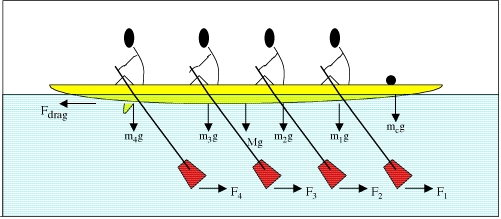
The sport of rowing involves numerous combinations and classes of athletes. Boats can be rowed with or without coxswains (the non-rowing captain) and by 1, 2, 4, or 8 rowers. Each rower can handle one oar (sweeping) or two oars (sculling). Racing shells are currently being made with Carbon or Carbon/Kevlar combinations. The act of rowing involves the transfer of momentum by the rowers and their oars to the water. The momentum is transferred to the water by pulling on the oar and pushing with the legs (the feet are attached to the boat by restraints). This causes the seat to slide backwards and the oars to pivot on the riggers. Each stroke is made up of four basic parts: catch (blade vertical in the water, knees bent, arms forward), drive (legs straight, arms pulling toward the body), finish (oar out of water, blade vertical), recovery (body moves forward, blade turns from vertical to the horizontal). For some of the basic forces acting on a 4+ (coxed four) see Figure 1.

Figure 1: mx is the mass for each rower x (1-4) and coxswain (c), M is the mass of the boat, and Fx (x=1- 4) is the force exerted by the stroke and Fdrag is the resistive force of the water.